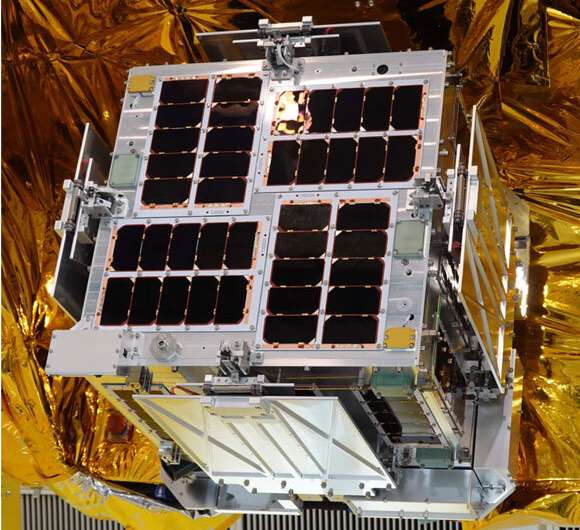It is also equipped with a small camera as an observation device for checking paddle operation, an optical telescope for precise attitude guidance, and an ultraviolet camera developed jointly with ABLIC Inc. The HIBARI mission is planned to include the photographing of ultraviolet radiation from the auroras over the North and South Poles, and observing the interaction site between the earth's magnetosphere and charged particles.
One of HIBARI's main exterior features is its system of four motor-driven, movable solar cell paddles for realizing VSAC. When driven properly, the recoil from the paddle movement can be used to quickly and efficiently control movements such as rotation and stopping to orient the satellite's attitude in any direction. HIBARI's high-precision and stable directional control is possible with the collaborative use of a reaction wheel (RW). In addition, since atmospheric drag changes when the four paddles are opened and closed, orbit control (descent) can be achieved without a thruster (propulsion device). By implementing variable shape functionality to the satellite itself and controlling it in this way, it becomes possible to control both the attitude motion and the translational motion, which are impossible to perform using a single conventional actuator, with high efficiency and without any propellant. For VSAC testing, a small camera will be used to capture the open/closed status of the paddles on orbit, and a precision attitude guidance control test will be conducted in collaboration with a star tracker and an optical telescope.
HIBARI is also equipped with UVCAM, an ultraviolet camera that was developed in collaboration with ABLIC Inc. Ultraviolet light, which are known to cause sunburn, are difficult to observe on earth since most are blocked by the ozone layer, etc., making it an unexplored wavelength band in the field of astronomy. In this research, line emission from the upper atmosphere and ultraviolet rays from the auroras over high latitude areas will be measured from outer space at an altitude of 550 to 565 km as a basic experiment for ultraviolet astronomical observation.
Next, a successor experiment of the 3-axis earth sensor DLAS using relative attitude estimation based on continuous earth imaging and AI-based image identification, which was demonstrated by ISTD-1, will be conducted as 3-axis attitude determination test using earth images. Then, a demonstration experiment will be conducted for real-time communication with the ground using the installed Globalstar transmitter STINGR. Also, HIBARI's mounted bus equipment was developed in compliance with the CubeSat standard as a microsatellite standard bus. After the separation in orbit, the satellite will automatically start the sun-acquisition operation to generate sufficient electric power. And the operation team led by Mr. Watanabe, a Ph.D. candidate, will check out the satellite system. Then they will move on to the steady state operation in which the various missions including the feasibility as a bus equipment for microsatellites will be conducted.

Background and details
Since "microsatellites" that weigh 100 kg or less can be developed quickly and at low cost, they are commonly used for space business. A research team headed by Professor Saburo Matunaga proposed a "research and development center for smart space devices and systems for the creation of new space industries" as part of the Space Cooperation Base Formation Program of the FY2018 MEXT Space Science and Technology Promotion Consignment Fund. To place Tokyo Tech as a center for space development for industry-academia collaboration, they have been actively promoting industry-academia collaboration in space by providing various information to industries from perspectives including basic technology for space development and overseas business trends.
This research is one of the projects created from this base formation project, and was established as a way to achieve more accurate observations with high efficiency in the remote sensing business. To accurately observe ground targets, the ability to quickly change attitude and achieve attitude stability for clear photos is essential. Since small satellites have a small moment of inertia, quick attitude adjustments are easy, but it is difficult, in principle, to maintain stability, and various studies have been conducted on this. To resolve such issues, this research group devised a unique satellite attitude control method called VSAC that utilizes the recoil from satellite structure deformation. In addition to realizing high-speed attitude adjustments with high efficiency, research and development has been conducted to achieve highly stable attitude-oriented control.
Tokyo Tech had already been developing satellites on its own. However, HIBARI is the result of the cooperation based on the "research and development center for smart space devices and systems for the creation of new space industries (smart space base)." The industry-academia collaboration with ABLIC Inc., who was in charge of developing UVCAM, is one of the collaborations resulting from this.
HIBARI is scheduled to be launched aboard Epsilon-5 from the JAXA Uchinoura Space Center sometime after November, 2021. After the satellite separates from the rocket, it enters the critical phase of operation until the solar array paddles are deployed. Next, system soundness is confirmed. Then, attitude control tests, attitude determination tests using earth images, and ultraviolet astronomical observations will begin in turn. The mission is expected to last for one year.
Explore further



